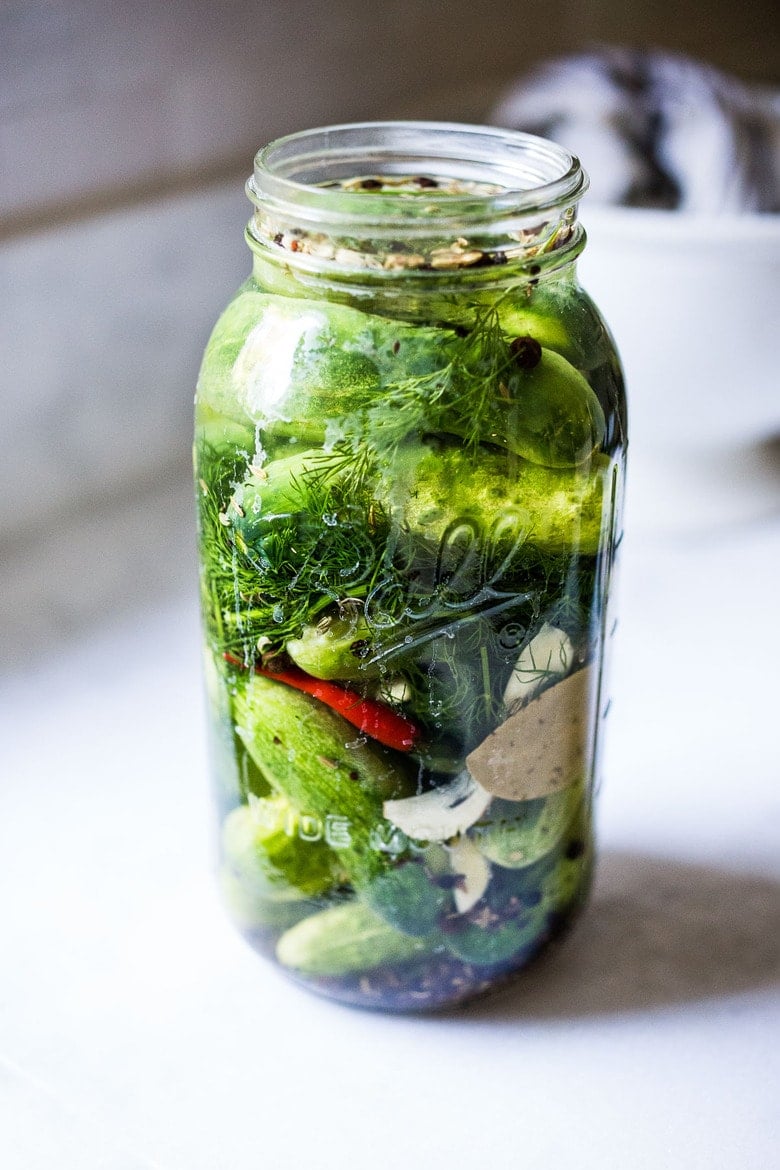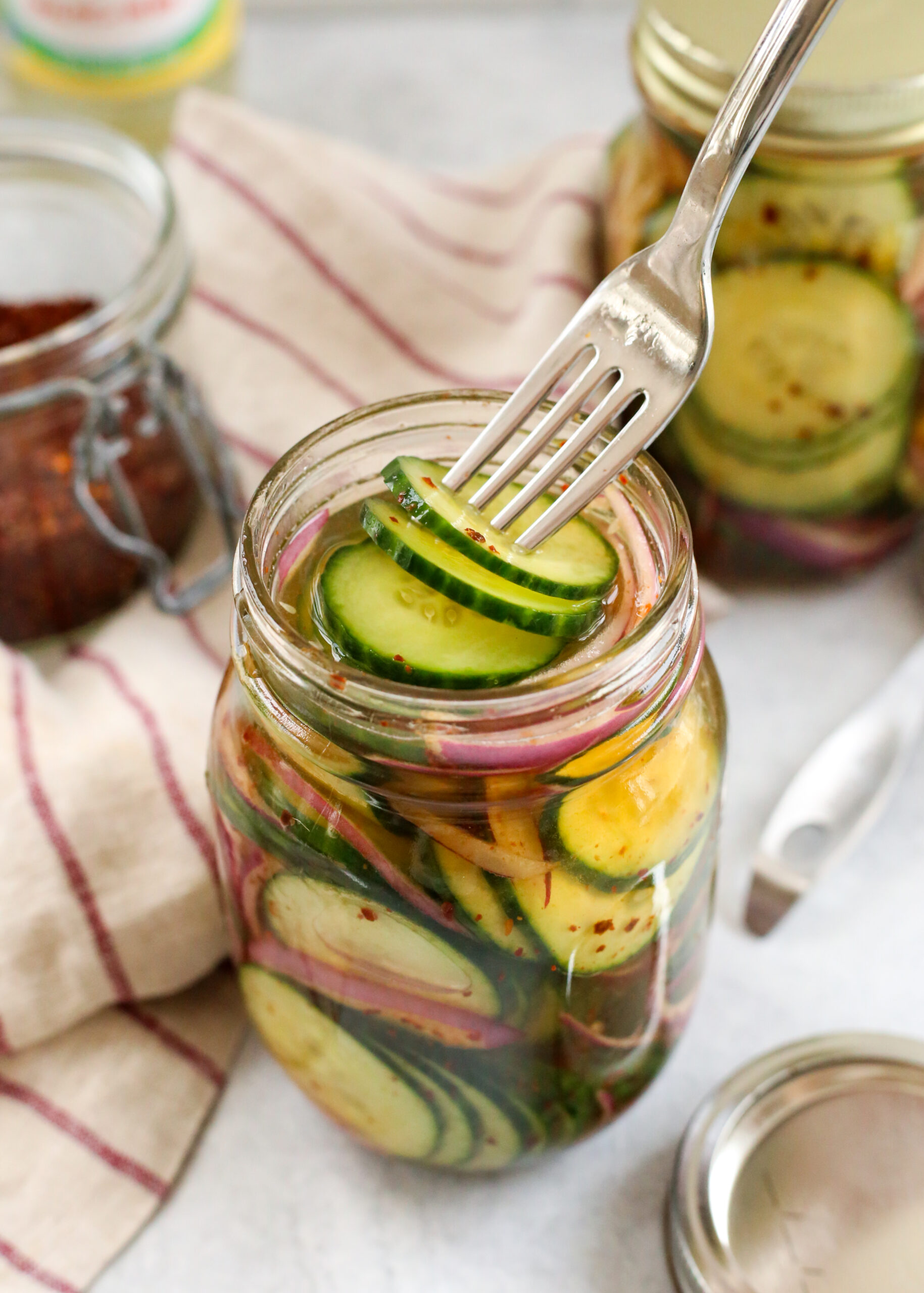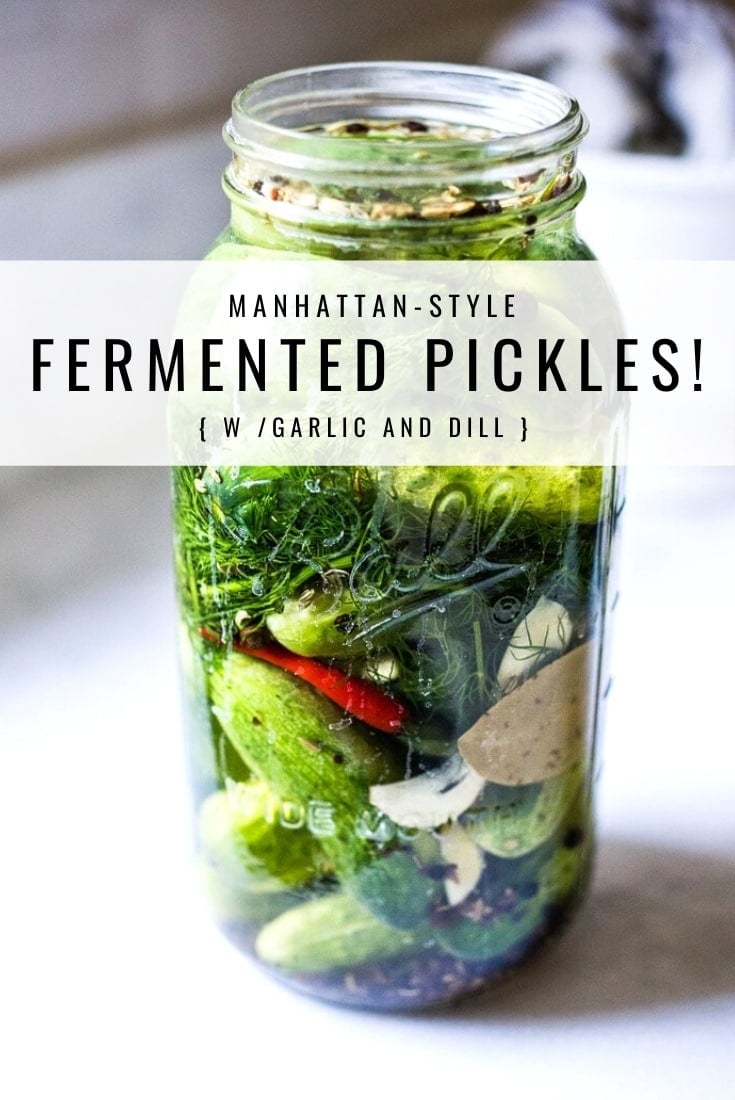The best way to measure ingredients for pickling is by using precise measurements. Accurate measurements ensure your pickles turn out perfect every time.
Pickling is both an art and a science. It preserves food while adding unique flavors. To achieve the best results, measuring ingredients correctly is crucial. Precise measurements affect the taste, texture, and safety of your pickles. Too much salt or too little vinegar can spoil the batch.
Measuring tools like cups, spoons, and scales help achieve consistency. Understanding the role of each ingredient also matters. This blog will guide you on the best ways to measure ingredients for pickling. Get ready to make delicious pickles with confidence.
Introduction To Pickling Ingredients
Pickling is an age-old method of preserving food that enhances flavors and extends shelf life. Understanding the ingredients used in pickling is crucial for achieving the perfect balance of taste and preservation. This section introduces you to the basic ingredients essential for successful pickling.
Basics Of Pickling
Pickling involves soaking food in a solution of vinegar, water, and salt. These components work together to preserve the food and enhance its flavor. Vinegar provides acidity, which inhibits bacterial growth. Water dilutes the vinegar, making the solution less harsh. Salt draws moisture out of the food, creating an environment where spoilage microbes cannot thrive.
Other common ingredients include sugar, which adds sweetness, and spices, which infuse the food with additional flavors. Each ingredient plays a specific role in the pickling process, making accurate measurement essential.
Importance Of Accurate Measurement
Accurate measurement of pickling ingredients ensures the safety and quality of the final product. Too little vinegar can result in an unsafe pH level, allowing harmful bacteria to grow. Too much salt can make the pickles overly salty and unpalatable. Precise measurement helps maintain the right balance of flavors and preservation.
Using a kitchen scale for solid ingredients and measuring cups for liquids can help achieve this accuracy. Consistency in measurements leads to consistent results, making your pickling efforts more successful and enjoyable.

Credit: www.feastingathome.com
Types Of Ingredients
Measuring ingredients accurately is crucial for successful pickling. Different types of ingredients need different measuring techniques. Let’s explore the key ingredient types for pickling.
Fresh Produce
Start with fresh, high-quality produce. Ensure the produce is clean and dry. Weighing produce is best. Use a kitchen scale for precise measurements. This ensures consistency in your pickles.
Vinegars
Vinegar is essential for pickling. It preserves and flavors the produce. Measure vinegar using a liquid measuring cup. Different vinegars can be used. White vinegar, apple cider vinegar, and rice vinegar are popular choices.
Spices And Herbs
Spices and herbs add unique flavors. Measure them with measuring spoons. Consistent measurements create balanced flavors. Common spices include mustard seeds, dill, and peppercorns.
Salt
Salt is crucial for pickling. It helps preserve and enhance flavors. Use pickling salt or kosher salt. Measure salt with dry measuring cups or spoons. Avoid table salt with additives. They can affect the quality of your pickles.
Measuring Tools
Hey friends, today I’m going to talk about something super important for pickling: measuring ingredients. If you’re like me, you want your pickles to turn out just right. The key to this? Using the right measuring tools. Let’s dive into the best tools to make sure your pickles are perfect every time.
Measuring Cups And Spoons
Measuring cups and spoons are the basics. They are great for dry ingredients like salt, sugar, and spices. You probably have these in your kitchen already. Just remember to level off your ingredients for the most accurate measurement. It’s like baking; precision matters.
- Cups: Use these for larger quantities like sugar or salt.
- Spoons: Great for smaller amounts of spices.
Digital Scales
Digital scales are fantastic for accuracy. They help you measure ingredients by weight. This is especially useful for things like vegetables. I recently used one to measure cucumbers, and my pickles turned out better than ever. It’s easy to use and ensures consistency.
Why use a digital scale?
- More precise than cups and spoons.
- Helps with consistent results.
- Easy to use – just zero out the scale and add your ingredient.
Liquid Measuring Cups
Liquid measuring cups are essential for measuring liquids like vinegar and water. They are usually clear, so you can see exactly how much you have. Make sure to place the cup on a flat surface and check it at eye level to get an accurate measurement.
Quick tip: Use a separate liquid measuring cup for different liquids to avoid mixing flavors unintentionally.
The good news? Using these measuring tools can make your pickling process much smoother. You’ll get consistent, delicious results every time. So next time you’re ready to pickle, grab your measuring cups, spoons, and digital scale. Your taste buds will thank you!

Credit: streetsmartnutrition.com
Weight Vs. Volume
Hey friends, today we’re diving into the world of pickling! One of the most common questions I get is about how to measure ingredients correctly. Should you use weight or volume? Well, let’s break it down together and see which method works best for pickling. Ready? Let’s go!
When To Use Weight
Using weight is often the most accurate way to measure ingredients. Why? Because it doesn’t matter how packed or fluffy your ingredient is. Think about it. A cup of chopped cucumbers can weigh different amounts depending on how tightly you pack them. But 100 grams of cucumbers will always be 100 grams.
Here’s when you should use weight:
- For precision: When you need exact measurements, like in baking or making pickles.
- For consistency: Ensuring each batch tastes the same.
- For small quantities: Like spices or salt, where a little difference can change the flavor.
I recently tried making a batch of dill pickles. I used weight to measure the cucumbers and salt. The result? Perfectly balanced pickles every time!
When To Use Volume
Volume can be handy too! It’s quick and easy. Just grab your measuring cups or spoons, and you’re good to go. But remember, it’s not always as precise as weight.
Here’s when volume works best:
- For liquids: Measuring cups are perfect for vinegar or water.
- For larger quantities: Like when you’re making a big batch and slight variations won’t matter.
- For convenience: If you’re in a hurry, volume measurements are faster.
Once, I was in a rush to make a quick pickle brine. I used volume measurements for the vinegar and water. It worked great, and the pickles were delicious!
So, there you have it. Whether you choose weight or volume depends on what you’re making and how precise you need to be. Happy pickling!
Measuring Solid Ingredients
Measuring solid ingredients for pickling is crucial for the best results. Precision ensures the right balance of flavors and proper preservation. In this section, we’ll explore the best ways to measure solid ingredients for pickling. This includes chopping and slicing techniques, as well as packing and leveling methods.
Chopping And Slicing Techniques
Proper chopping and slicing affect the texture and flavor of pickles. Uniform pieces ensure even pickling. Use a sharp knife or mandoline for consistent cuts. For cucumbers, slice them into even rounds or spears. Carrots can be cut into sticks or coins. Always aim for similar sizes to ensure even brining.
Consider the thickness of the slices. Thinner pieces pickle faster and absorb more brine. Thicker pieces retain more crunch. Adjust your slicing method based on your desired outcome.
Packing And Leveling
Packing solid ingredients properly in jars is essential. Tightly packed jars prevent floating and ensure even brining. Place larger pieces at the bottom. Fill in gaps with smaller pieces. This helps to maximize jar space and ensures even pickling.
Leveling the ingredients is also important. Ensure the top layer is below the jar rim. This prevents overflow during the fermentation process. Use a utensil to press down the ingredients. Remove air pockets for better brine coverage.
Measuring solid ingredients with care leads to the best pickling results. Consistent chopping and proper packing ensure flavorful and well-preserved pickles.
Measuring Liquid Ingredients
Hey friends! If you’ve ever tried pickling, you know that getting the measurements right is key. Especially when it comes to liquids. Too much or too little can make or break your pickles. So, what’s the best way to measure liquid ingredients for pickling? Let’s dive in!
Proper Techniques
First things first, using the right tools is important. You’ll want to grab a liquid measuring cup. These cups are usually clear and have markings on the side. Here’s how to use them:
- Place the cup on a flat surface: This keeps the liquid level and accurate.
- Bend down to eye level: Check the measurement at eye level to get the most accurate read.
- Pour slowly: Add the liquid slowly to reach the desired mark without going over.
It’s that simple! But there’s more to it. Let’s talk about avoiding spills.
Avoiding Spillage
Spilling liquid can be a mess. And a waste. Here’s how to avoid it:
- Use a funnel: This helps direct the liquid right where you want it. No mess, no waste.
- Pour over the sink: If you do spill, the mess is contained. Easy clean-up!
- Take your time: Rushing only leads to spills. Pour slowly and carefully.
I recently asked my friend who’s a pickling pro for some tips. She swears by the funnel method. She said, “I never spill a drop anymore! It’s a game-changer.”
So there you have it, friends! Measuring liquid ingredients for pickling doesn’t have to be a hassle. With these simple tips, you’ll be a pickling pro in no time. Happy pickling!
Common Mistakes
Pickling is a wonderful way to preserve food. But common mistakes can ruin your efforts. Knowing what to avoid helps you get the best results. Let’s dive into the frequent errors people make.
Overpacking Ingredients
Overpacking is a big mistake in pickling. When jars are too full, ingredients can’t move. This leads to uneven pickling. Make sure there’s enough room. Leave about half an inch of space at the top. This ensures the liquid can circulate.
Incorrect Measurements
Incorrect measurements can throw off your recipe. Too much salt or sugar changes the taste. Not enough vinegar can spoil the batch. Always use proper measuring tools. Be precise with your ingredients. This guarantees a balanced flavor.
Expert Tips For Accuracy
Hey friends, ever wonder how to get the perfect pickle every time? The secret lies in accurate measurements. Today, we’ll share some expert tips to help you get consistent, delicious results. These tips will make sure your pickles are always top-notch.
Calibrating Tools
First things first. Calibrating your tools is crucial. Think of it like tuning a guitar. If it’s off, the music (or in this case, your pickles) won’t be right. Here’s how you can ensure your tools are ready:
- Use a reliable kitchen scale. Make sure it’s zeroed before each use.
- Check your measuring cups and spoons against a standard. They wear out over time.
- Replace old tools. A worn-out scale or a bent spoon can throw off your measurements.
It’s as simple as that. Properly calibrated tools mean more accurate measurements.
Consistency In Measurements
Consistency is key. Imagine baking a cake with random amounts of ingredients. It wouldn’t work, right? Pickling is the same. Here are some tips for consistent measurements:
- Level off your dry ingredients. Use a knife to scrape off the excess.
- Use liquid measuring cups for liquids. They’re designed to give you a clear view of the measurement line.
- Measure by weight whenever possible. It’s more precise than volume.
Doing this will help you get the same great taste every time.
I remember the first time I tried pickling. I used a tablespoon that was slightly bent and my pickles were too salty. Lesson learned! Accurate tools and consistent measurements make all the difference.
So, next time you’re ready to pickle, remember these expert tips. Your taste buds will thank you!
Conclusion And Best Practices
Accurate measurement of ingredients ensures perfect pickling. Use measuring spoons and cups for precision. Always follow trusted recipes.
Hey friends, we’ve gone through a lot about measuring ingredients for pickling. It’s been quite a journey, right? Now, let’s wrap things up with some key points and final tips to ensure your pickling adventure is a success.Summarizing Key Points
To make sure everything stays clear, here are the main things to remember: – Accuracy is Key: Always use proper measuring tools. A good kitchen scale and measuring cups are your best friends. – Consistency Matters: Stick to the recipe. Small changes can make a big difference. – Quality Ingredients: Fresh and high-quality ingredients make the best pickles. Don’t compromise. – Sanitize Everything: Cleanliness is crucial. Sterilize jars and tools to avoid contamination.Final Tips For Success
Want to nail your pickling process every time? Here are some final tips: 1. Double-Check Measurements: Always double-check your measurements. It’s better to be sure than to end up with something off. 2. Label Your Jars: Once you’ve sealed your jars, label them with the date and contents. This helps in tracking the pickling process and knowing when they’re ready to eat. 3. Store Properly: Keep your pickles in a cool, dark place. This helps them last longer and taste better. 4. Patience is a Virtue: Let the pickles sit for the recommended time before tasting. Good things come to those who wait! Remember, pickling can be a fun and rewarding process. I recently tried a new recipe for dill pickles and followed these best practices. The result? Delicious, crunchy pickles that my family loved. To wrap it up, stick to these guidelines and you’ll be on your way to making perfect pickles every time. Happy pickling! “`
Credit: www.feastingathome.com
Frequently Asked Questions
What Are The Measurements For Pickling?
For pickling, use 1 part vinegar, 1 part water, and 1 tablespoon salt per cup of liquid. Adjust spices to taste.
What Is The 321 Rule For Pickles?
The 321 rule for pickles involves using 3 cups of vinegar, 2 cups of sugar, and 1 cup of water. This ratio ensures a perfect balance of flavors for pickling.
What Is The Best Way To Measure Ingredients?
Use measuring cups and spoons for accuracy. Level off dry ingredients with a straight edge. Use liquid measuring cups for liquids.
What Is The 321 Method Of Pickling?
The 321 method of pickling involves 3 parts vinegar, 2 parts sugar, and 1 part water. This simple ratio creates a balanced, flavorful brine for preserving vegetables.
Conclusion
Accurate ingredient measurement is key for perfect pickling. Use digital scales for precision. Always level off dry ingredients with a straight edge. Use liquid measuring cups for liquids. Consistency ensures safety and flavor. Practice makes perfect. Happy pickling!
